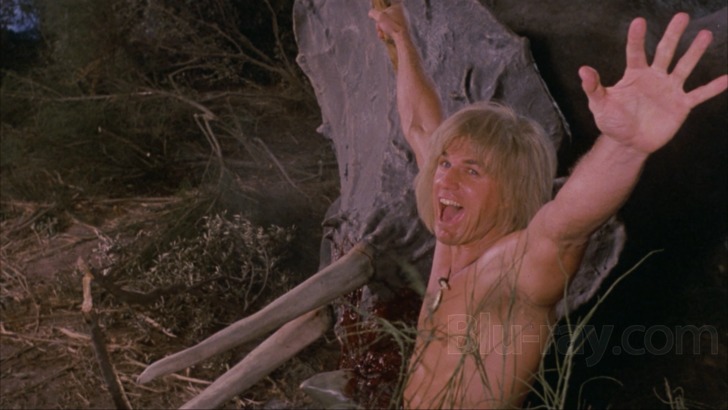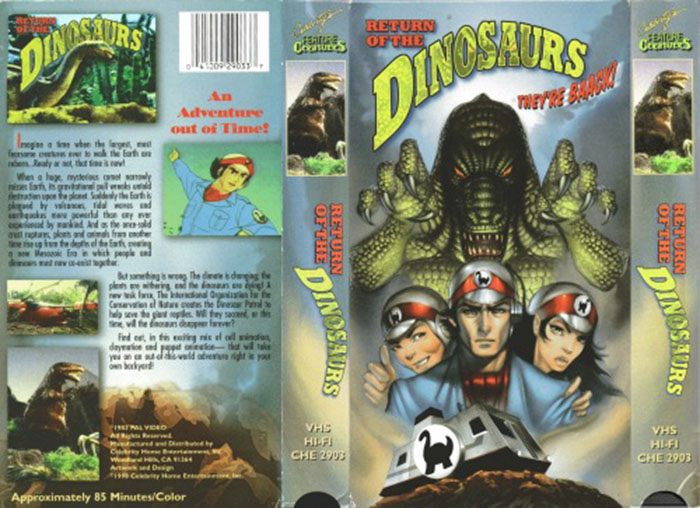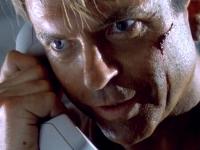Most Bizarre Dinosaur Movies From Around The World

Most movie fans can name all the best dinosaur movies without needing a prompt: the "Jurassic Park" franchise, the 1933 and 2005 versions of "King Kong," and even "One Million Years B.C." and "The Valley of Gwangi," both featuring groundbreaking stop motion animation by the legendary Ray Harryhausen. They may even cite cult favorites, like Roger Corman's gonzo "Carnosaur," or kid-friendly titles like "Walking with Dinosaurs" and "The Good Dinosaur."
That list represents only a small faction of the dinosaur movies that have been made since the dawn of motion pictures. It doesn't include "mockbusters" like The Asylum's "Triassic World," '50s sci-fi features like "Lost Continent," and the enjoyable if threadbare UK fantasy "The Land That Time Forgot" from 1973. But again, that lineup barely scratches the surface of dino cinema. There are also countless Cretaceous features made in Europe, Asia, and all points on the globe, as well as ultra-low-budget American titles seen only by the most dedicated movie archaeologists. Following is a list of the strangest saurian flicks from around the world.
Spoilers are sure to follow.
Legend of Dinosaurs and Monster Birds is kaiju on a budget

In the 1977 Japanese fantasy-horror film "Legend of Dinosaurs and Monster Birds," the simultaneous discovery of fossilized eggs and a hungry lake monster near Mount Fuji prompts an investigation by the least capable people possible — namely, a dad-obsessed, woman-hating geologist, his constantly screaming ex-girlfriend, and another woman whose primary role is to also scream with abandon. Their haphazard research results in the death of nearly everyone they encounter, from the secondary screaming woman to the entire audience at a lakeside country festival (guns with hair triggers and depth charges don't mix) and finally, the scientist and long-suffering ex themselves, though this last element is left to the audience's imagination. Large puppets meant to represent an aquatic creature — though not a dinosaur — and a flying reptile (also not a dinosaur, nor a monster bird) are tangentially involved.
"Legend" is a shameless "Jaws" steal from Japan's Toei Company, which found considerable success during its long history with ghost stories and tokusatsu like the "Johnny Sokko and His Flying Robot" and "Super Sentai"/"Power Rangers" series. It was not particularly adept at kaiju films, as this feature clearly indicates, though attempts here to cover up that deficiency with copious gore and monster-on-human action — along with a tone-deaf disco score – provide enough laughs or quizzical reactions to obfuscate its shortcomings.
No, World of Wonders is not a '90s PC game

As the advertising for this Tamil-language feature noted with great insistence, 2012's "Adhisaya Ulagam" ("World of Wonders") was India's first dinosaur movie in 3-D, which is perhaps the only superlative that's applicable to the film. A nominal kids' adventure which sends a pair of bratty pre-teens and their dotty scientist grandfather (comic actor Livingston) back to prehistoric times courtesy of his experimental time machine, "World of Wonders" announced its problems early with the introduction of the grandfather's sidekick, a talking dog rendered in computer animation that wouldn't have passed muster in a mid-priced laptop game from the late '90s.
Things get progressively worse with the arrival of various dinosaur species, which stiffly roar and stomp (and consume each other) while the three leads gamely go through the motions of seeming to interact with their CGI co-stars via shoddy green screen. The 3-D effects are relegated to objects hurled at the viewer, much as it was a half-century before when 3-D was still a novelty. Critical reaction to "World of Wonders" seems to vary from disbelief to dazed acceptance.
Dinosaur from the Deep: backyard moviemaking at its weirdest

In the distant future of "Dinosaur from the Deep" — the year 2004 — the death penalty has been outlawed. So the answer for punishing a notorious criminal is to send him into the past, when capital punishment remains an option! As a cost-saving measure, the portly, balding bad guy carpools with a scientific research team (led by French exploitation director Jean Rollin) to the prehistoric past, which goes completely awry. He flees into the Jurassic landscape, requiring the scientists to track him down while being stalked by various dinosaurs.
Sounds pretty good, or at least like bad fun, but that, friends, is where you would be wrong. 1993's "Dinosaur from the Deep" is one of several amateur films made by French magazine publisher and comic/video store owner Norbert Moutier, whose understanding of the most rudimentary filmmaking techniques can be charitably described as non-existent. Think of the crummiest backyard movie you've ever seen (or made) — Moutier's directorial capabilities are on par, if not worse. Scenes run on forever, change from day to night within a single edit, and are frequently out of focus or framing objects in the least appealing way.
Moutier's mix of rubber toys, crude, herky-jerky clay models, and hand puppets inspire dropped jaws not only for their ineptitude, but for how much screen time they're afforded. Astonishingly, "Dinosaur from the Deep" isn't Moutier's only film: he also made slasher movies ("Mad Mutilator") and action titles ("Operation Las Vegas"), many of which are available online for your enjoyment (?).
King Kong's FX creator also gave us The Giant Behemoth

Thousands of dead fish -– and one dead fisherman –- off the coast of Cornwall, England, lead American scientist Gene Evans and his UK counterpart, Andre Morell, to the discovery of a huge marine dinosaur that can emit a electrical pulse like an eel, only with an added and lethal dose of radiation. "The Giant Behemoth" — a 1959 US/UK production — owes more than a tip of the hat to "The Beast from 20,000 Fathoms," from which it borrowed co-writer/director Eugene Lourie, co-writer Daniel James, and more than a few plot developments.
The picture's chief selling point is its stop-motion special effects supervisor, Willis O'Brien, who attained movie immortality as the man who designed and animated the 1933 "King Kong." O'Brien and assistant Pete Peterson, who handled most of the actual animation work on the monster, completed their effects in a studio in Los Angeles, which was then edited into the live-action footage from England. The effects are decidedly subpar, especially when compared to O'Brien's previous work and that of his former protégé, Ray Harryhausen, on "Beast," but the monster's unique abilities add an entertaining wrinkle to the city-wrecking element.
Was it necessary to Return to the Lost World?

Shot back-to-back with the 1991 adaptation of Sir Arthur Conan Doyle's "The Lost World," Timothy Bond's "Return to the Lost World" is essentially a retread of its predecessor, trotting out John Rhys-Davies and David Warner to reprise their roles as squabbling explorers who lay claim to a stretch of the Congo that houses prehistoric animals. With the Lost World already discovered, the focus here is saving it from a diabolical oil operation that inadvertently triggers a volcano which could destroy the area and its inhabitants.
As with its predecessor, "Return to the Lost World" is a co-production between Harry Alan Towers and Frank Agrama's Harmony Gold USA. Both filmmakers have a long history of producing schlock and landing in hot water on the legal front, and their penchant for cost-cutting is evident here in the atrocious special effects. Dinosaurs are rendered with puppets and performances are risible; Rhys-Davies, Warner, and Eric McCormack have the look of actors biding their time until the production runs out. If there's something good to be said about "Return to the Lost World," it's far better than Asylum's mockbuster "King of the Lost World," which folds a giant ape into the mix.
The Witches Cave: swords, lasers, and mammoths

Prolific Soviet science fiction author Kir Bulychyov adapted his own novel for the 1989 Russian/Czech feature "The Witches' Cave", which whips various sci-fi tropes — interstellar travelers, Lost World planet — into a frothy frappe and liberally salts the brew with poverty-strapped special effects. The premise — which has been noted for its passing similarities to the "Star Trek: Original Series" episode "A Private Little War" –- pits an upstanding young spaceman against a brutal warlord who threatens a primitive tribe and a survey team of researchers on a distant planet.
How the warring tribes live Stone Age lives but possess steel weapons requires lengthy and ultimately dull plot convolutions. Far more astonishing is the planet's flora and fauna, which range from giant spiders to pterosaurs and wooly mammoths, as well as an ape man who would fit in well with a '50s-era prehistoric epic. All of these are rendered with astonishingly poor stop-motion animation and puppets, which may be the picture's primary appeal.
Adventures in Dinosaur City was a '90s TV staple

If you spent any amount of time in front of a television during the '90s and 2000s, it's likely that you stumbled upon the 1991 American kids' fantasy film "Adventures in Dinosaur City," most likely on the Disney Channel. It's also likely that after watching a few minutes of the film, you may have experienced deep pangs of regret for that lost time. A barn door-broad comedy with a goofball premise — three kids (including Omri Katz from "Hocus Pocus") are inadvertently transported into their favorite TV series, "Dinosaurs," which plays a lot like the Jim Henson series of the same name — "Dinosaur City" is saddled with an inert storyline, anthropomorphic "cool" dinosaurs, and eye roll-inducing dialogue.
All of which is a surprise, given that the film has a lot of behind-the-scenes talent. Co-writer/co-producer Lisa Morton is a successful and award-winning horror author, while director Brett Thompson helmed the enjoyable documentary "The Haunted World of Edward D. Wood, Jr.." The dinosaur designs — which are the highlight of the film — were courtesy of second unit director John Criswell, who worked on the Henson "Dinosaurs" series and "Where The Wild Things Are," among many other films. Of course, all the talent in the world can't save a movie as DOA as "Dinosaur City," but its pedigree is impressive.
My Pet Dinosaur sure loves Steven Spielberg

The 2017 Australian children's adventure "My Pet Dinosaur" delivers the saurian goods via an offbeat premise: aliens shower a small town with glowing globs that transform into prehistoric creatures when exposed to water. One such critter is adopted by lonely Jordan Dulieu, who sees the spiky quadruped as a buffer for his family issues (jerky big brother, absent dad who stuck the kids with his last girlfriend). Standing in the way of his boy-and-his-dog bliss with Magnus (the moniker he gives the dinosaur) is a military commander (Rowland Holmes) who goes to some extreme lengths to add the creature to his collection.
Though reviewers have not been kind to "My Pet Dinosaur," the feature, directed by Matt Drummond (a visual effects supervisor on "Grimm" and various direct-to-video creature features) isn't terrible. Yes, it wasn't the best decision to set the story in America, which requires the Australian cast to adopt spotty accents, but the CGI effects are acceptable, and Magnus has enough personality to appeal to pet-loving (or pet-hopeful) kid viewers).
The chief issue is the script's slavish devotion to all things Spielberg, which awkwardly pushes the film into an contrived tribute to "E.T.," with a dash of "Jurassic Park" for not-very-good measure. Those who see past the drawbacks of "Pet Dinosaur" may consider a double bill with Drummond's previous kid-friendly feature, "Dinosaur Island."
Yor, the Hunter from the Future has dinos, cavemen, and UFOs

Actor Reb Brown – best known for playing Captain America in a pair of NBC TV-movies in the 1970s — dons a loincloth to play a seemingly primitive warrior in the Italian/French/Turkish production "Yor, the Hunter from the Future," which was adapted from an Argentine comic book and whittled down from a four-hour TV miniseries. The nominal plot — in which the Stone Age-styled Yor fights blue tribesmen, androids, mummies, and flying saucers to discover that he is the son of survivors of a nuclear war (!) — is made exponentially more awesome by the appearance of several dinosaurs, though how they returned to life after millions of years and an atomic apocalypse is never quite explained. Does it matter? It's future cavemen with lasers fighting dinosaurs!
Paleontology experts and dino movie devotees will note that the creatures depicted in "Yor" are a mix of science fact and fantasy. The Triceratops that attacks Yor's female companion, Kala (Corrine Clery from "Moonraker"), sports the dorsal plates of a Stegosaurus, though the Dimetrodon that tangles with Yor is a fairly accurate representation. There's also a giant bat/flying lizard thing that Yor turns into a hang glider, but so far, it hasn't turned up in the history books.
Return of the Dinosaurs is an odd TV series from Godzilla's creator

According to "Return of the Dinosaurs," an asteroid passed Earth in 1996 and unleashed a torrent of natural disasters, which in turn freed an army of dinosaurs that had been living under the planet's surface for centuries. Enter the Born Free team, a group of scientists (and the obligatory kid who gets to pal around with them) charged with rounding up the dinosaurs while also contending with King Buttler, a big game hunter fixated on the idea of adding a dinosaur head to his collection.
"Return" was a 1976 small-screen effort from Tsuburaya Productions — the film and TV company launched by special effects legend Eiji Tsuburaya, who created Godzilla and his friends. The feature-length "Return of the Dinosaurs" was compiled from the series "Kyoryu Tankentai Born Free," which hinged on an odd, cost-saving measure: the human cast of the series was depicted with 2-D animation, while the dinosaurs, elaborate sets, and wealth of vehicles were rendered with stop-motion animation and miniatures. Depending on your affinity for either form, they clash mightily or work together effortlessly; but reducing the series to a single feature and strapping it with atrocious English dubbing, as seen in "Return," only makes matters worse.
"Born Free" was followed by two additional series — "Dinosaur War Izenborg," which pitted evil dinosaurs against a giant robot and its crew, and "Dinosaur Squadron Koseidon," which abandoned the 2-D animation in favor of an all-tokusatsu/suitmation approach.
Dinosaurs are the least bizarre aspect of Iron Sky: The Coming Race

In a movie packed to the gills with lizard people, hollow earth theories, Nazis on the moon, the Holy Grail, and a cult that worships Apple founder Steve Jobs (played by Tom Green), you might think that there wouldn't also room for dinosaurs. But the 2019 Finnish-German-Belgian sci-fi/fantasy "Iron Sky: The Coming Race" is the work of Finnish director Timo Vuorensola, for whom absurd excess is a point of pride. There are plenty of dinosaurs on hand in the film, including a Lost World filled with impressive CGI saurians and a Tyrannosaur named Blondi that serves as faithful steed for none other than the revived Adolf Hitler (played by cult favorite Udo Kier).
"The Coming Race" — which was largely crowdfunded by fans — is the sequel to Vuorensola's equally out-to-lunch 2012 film "Iron Sky," which set in motion the whole moon Nazi premise. Though "Coming Race" stumbled at the box office, be forewarned: a third film in the series has been announced/threatened.
Peacock King pits demon dinosaurs against martial arts

It's important to note that the scene in the 1988 Hong Kong/Japanese fantasy "Peacock King," which pits martial arts legend Yuen Biao against magically reanimated dinosaurs, is only the fourth or fifth most jaw-dropping moment in the picture. That's because "Peacock King" -– based on the long-running manga series by Makot Ogino –- is chock full of the absolutely insane fantasy and action sequences that made Hong Kong films a must-see in the late '80s and early '90s.
The effects here aren't quite on par with such Hong Kong cinema high water marks as "Zu: Warriors from the Magic Mountain" or "A Chinese Ghost Story," and director Lam Ngai Kai – who oversaw such berserk HK films as "The Seventh Curse" and "Riki-Oh: The Story of Ricky" — seems overwhelmed. But he's also trying to traffic-control a movie which pits two monks (Biao and Hiroshi Mikami) against the Hell Witch (Siu-Fung Wong), who unleashes the Hell Virgin (Gloria Yip), armies of evil spirits and possessed warriors, and the aforementioned dinosaurs in an attempt to free the King of Hell. The resulting mayhem is never less than entertaining, even when the flurry of action — did we mention that '70s Shaw Brothers superstar Gordon Liu of "Kill Bill" is in the mix, too? — threatens to overpower the viewer.
Reptilicus: the marionette that massacred Copenhagen

In 1961's "Reptilicus," the tail of an enormous prehistoric reptile, found frozen in Lapland, produces fresh blood when damaged. So it's sent for study to Denmark, where it regenerates into a complete creature that puts a considerable dent into the Old World charm of Copenhagen and its surrounding towns. American producer Sidney W. Pink's infamous Danish science fiction thriller was filmed twice – once in Danish for director Poul Bang and once in phonetic English by Pink — but neither version can compensate for its jaw-dropping monster, a ceaselessly squalling dragon of sorts, depicted at various times in the film by a floppy marionette and a stiff, wooden model.
The curious are encouraged to seek out both versions for their respective oddball moments: the Danish "Reptilicus" features scenes of the monster in flight and a long musical number featuring comic Dirch Passer and a group of children celebrating the monster in song. The American edit trims away both of these scenes (and much of not one but two romantic subplots), yet adds a "Godzilla"-like touch to the creature with crude animation that suggests that it can spew up a toxic green venom. However, neither Bang nor Pink saw fit to excise a long travelogue sequence that visits various tourist spots in Copenhagen while pop singer Berthe Wilke warbles "Tivoli Nights."
Mystery on Monster Island makes ill use of cult actors

"Mystery on Monster Island" is a very loose adaptation of Jules Verne's 1882 novel "Godfrey Morgan" (and not "Mysterious Island," as is often suggested) by Spanish director Juan Piquer Simon, whose previous credits include two of the most disgusting and inept horror movies of the 1980s, the slasher film "Pieces" and the nature-gone-amok thriller "Slugs." Simon reins in the gruesome stuff for this Spanish-U.S. production, and benefits from the presence of three cult icons — actors Peter Cushing, Terence Stamp, and Spanish horror hero Paul Naschy – but still proves incapable of making anything but a laughable mess, despite the source material.
Chief among the problems is that the name actors are barely in the film: Cushing turns up briefly as the wealthy uncle who dispatches hapless Ian Sera on an adventure in order to prepare him for marriage (!), while Stamp is glimpsed briefly in the conclusion as the film's resident heel. Naschy fares even worse as a pirate who is dispatched after mere minutes of screen time.
As for the "monster" part of "Monster Island," there are some dinosaur-like creatures — a toothy quadruped and a bipedal hulk — as well as more exotic animals, including goo-spewing centipedes and some seaweed-draped marine monstrosities. Their ludicrous construction pushes the picture into kids' matinee territory, which is perhaps the best audience for this pulpy wreck.
Source: www.looper.com/








